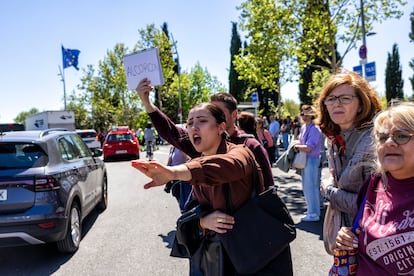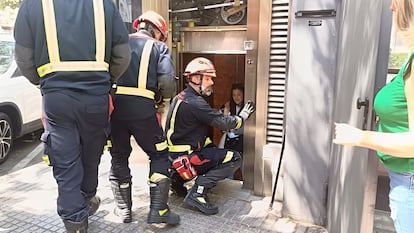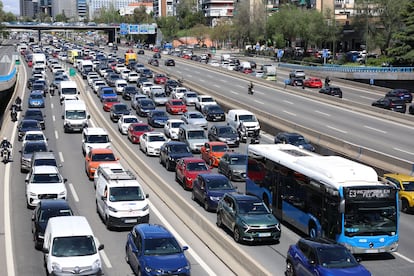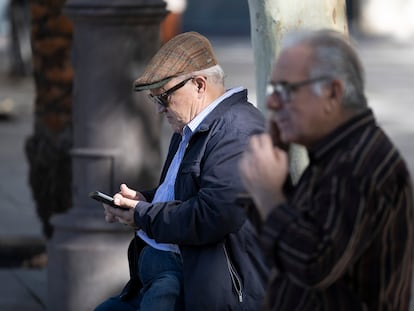No subway, no traffic lights, no elevators and no coverage in Madrid due to the blackout: ‘Can I borrow your phone to call my mom?’
The heart of Spain’s capital is filled with pedestrians looking for a way home, parents trying to pick up their children from school and traffic jams

At the stroke of midday, José Vicente de los Mozos, president of IFEMA and CEO of Indra — a Spanish information technology and defense company — leaves the fairgrounds because of a schedule change he has known about for hours. About fifteen journalists have been listening to him talk about the organization’s financial results deep within the infrastructure — a giant 200,000-square-meter complex embedded in the north of the capital — and watch him rush off. Then, darkness. No backup generator kicks in. No emergency lights, either. The power grid has gone down, and only the screens of phones and laptops faintly light up the meeting room, along with the feeble glow of a few dying lamps. A day of chaos has just begun, as the worst power blackout in Spain’s recent history paralyzed the country.
“Well, it looks like the press conference is over,” someone is heard saying. The IFEMA managers quickly shift from joking to action. Orders are given to open all the doors of the site, which has little activity this Monday. The parking barriers are lifted. When a visitor tries to take the elevator downstairs, they are advised to use the stairs instead. It’s good advice: by mid-afternoon, Madrid’s firefighters have counted 210 incidents, most of them to rescue people trapped in elevators, and SAMUR— Spain’s emergency system — has reported 167 emergencies, mainly due to respiratory issues and anxiety attacks.
When all the attendees of the press conference step outside, they are met with chaos. Traffic lights aren’t working. Traffic moves like in the Wild West: whoever accelerates first wins. Every roundabout becomes an adventure. Cell phone coverage comes and goes. A neighbor watches from her balcony as an unknown pedestrian talks on the phone and shouts at him.
—Is your phone working?
—Yes!
—Will you wait for me, and I’ll go downstairs to call my mom? I can’t reach her. Can I borrow your phone?

Exceptional situations produce exceptional events, like this unexpected encounter between two residents of neighboring apartment blocks who had never spoken before. He ends up saving her mother’s phone number in his mobile. She, desperate for news — since the radio, TV, and internet are all down — grows increasingly frantic: although her phone has a signal, no one answers on the other end. “This must be Putin’s doing,” she mutters, just as her phone, finally, begins to ring.
All around the scene, more chaos. Two parents split up: the woman, pushing a stroller, heads to the daycare to pick up their baby; the man goes to fetch their older children from school. Police block off lanes at roundabouts to ease traffic flow and also work to maintain order at key transport hubs. But without traffic lights, it’s nearly impossible. They worry: what will it be like at rush hour?

That must be exactly what the parents crowding the gates of two schools on Arturo Soria Street fear. They have arrived an hour and a half before pickup time to collect their children before more families flood the area and turn the neighborhood, without traffic lights, into a trap.
At one of these schools, teachers worry about what to do with a diabetic child who can’t recharge the phone he uses to monitor his condition. The father who shows up to pick him up faces another problem: figuring out how long the insulin he needs to inject him with will last without the necessary refrigeration. Around them, the other children carry on with their classes as if nothing were happening — happier than usual even, since the lack of power has given them more time for recess.
At a nearby Mercadona supermarket, two cars are parked across the middle of a lane, their trunks being loaded with all kinds of food. Shouting and insults erupt, because if traffic was already difficult without traffic lights, the two vehicles are making it even worse. But that’s the least of it: the roads leading into the capital, like the M-30, have turned into a monumental traffic jam since three in the afternoon.

Pedestrians watch everything without intervening, likely too preoccupied with their own troubles: the normally peaceful avenues have today turned into highways, and crossing the street has become an extreme sport. There are also those completely oblivious to the situation: an elderly couple strolls along a dirt path, dressed as if preparing to conquer Mount Everest, smiling behind their sunglasses, with boots and trekking poles in hand.
Tension in the city center
But the tense calm in the outskirts of Madrid turns into pure, raw tension in the city center. While the mayor, José Luis Martínez-Almeida, announces the closure of the M-30 tunnels, and the regional president, Isabel Díaz Ayuso, calls for the possibility of military intervention, the sidewalks of Paseo de la Castellana and other streets fill with people trying to get home because they can no longer work; with parents worried about their children’s schooling today and in the coming days (will schools open tomorrow?); and with tourists, lost and helpless in the chaos.
There is no subway. High-speed trains are not operating, either. Nor is Barajas Airport. People rush to grab any available taxi. The roundabout at Plaza de Cibeles is a nightmare. Everyone walks toward Atocha Station, hoping they might find some way to travel from there. Around the roundabouts, there are pedestrians holding signs with the destination they hope to reach — places that, under the punishing spring sun of Madrid, feel very far away.
“We don’t know anything, only that it’s a massive blackout,” says Luis, a Mexican tourist at Atocha Station who had planned to leave Madrid for Barcelona at three in the afternoon on Monday, along with two of his friends. The station is closed.
Like many others, Oriol is also trapped. He was one of the 30 volunteers who ran 42 kilometers in the marathon held in the capital on Sunday, alongside 12 patients in wheelchairs, to raise awareness of their rare disease: ataxia telangiectasia. This Monday, he is trying to return to Barcelona along with two of the patients who participated in the run, Luis and Álvaro, and their mother. All without success. “We have to wait. We’ve slept here for three nights, and their mother is trying to call the hotel to see if they have space,” he says, just before the police clear the station entrances.
The same scene — crowds of people searching for a way home — repeats itself at other transport hubs, like Moncloa in the west of the capital, which connects to cities such as Pozuelo, Majadahonda, and Boadilla del Monte. Because in Madrid, with seven million inhabitants, when everything shuts down, chaos erupts and worry follows.
Tu suscripción se está usando en otro dispositivo
¿Quieres añadir otro usuario a tu suscripción?
Si continúas leyendo en este dispositivo, no se podrá leer en el otro.
FlechaTu suscripción se está usando en otro dispositivo y solo puedes acceder a EL PAÍS desde un dispositivo a la vez.
Si quieres compartir tu cuenta, cambia tu suscripción a la modalidad Premium, así podrás añadir otro usuario. Cada uno accederá con su propia cuenta de email, lo que os permitirá personalizar vuestra experiencia en EL PAÍS.
¿Tienes una suscripción de empresa? Accede aquí para contratar más cuentas.
En el caso de no saber quién está usando tu cuenta, te recomendamos cambiar tu contraseña aquí.
Si decides continuar compartiendo tu cuenta, este mensaje se mostrará en tu dispositivo y en el de la otra persona que está usando tu cuenta de forma indefinida, afectando a tu experiencia de lectura. Puedes consultar aquí los términos y condiciones de la suscripción digital.
More information
Archived In
Últimas noticias
The metaverse, four years later: Is it finished or just at a standstill?
$3,000 and a plane ticket: The United States increases incentives for migrants to self-deport before the end of the year
Charles Dubouloz, mountaineering star, retires at 36 with a farewell tour inspired by Walter Bonatti
From the White House to diplomatic gifts: Lego wins over adult fans, brick by brick
Most viewed
- The low-cost creative revolution: How technology is making art accessible to everyone
- Christian Louboutin: ‘Young people don’t want to be like their parents. And if their parents wear sneakers, they’re going to look for something else’
- All the effects of gentrification in one corner of Mexico’s Colonia Roma
- Christmas loses its festive spirit: ICE fears cast shadow over religious celebrations
- Liset Menéndez de la Prida, neuroscientist: ‘It’s not normal to constantly seek pleasure; it’s important to be bored, to be calm’










































